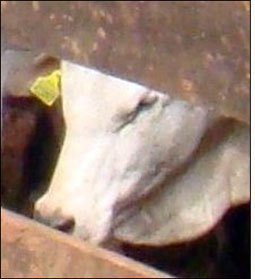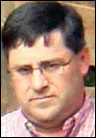The U.S. Department of Agriculture (USDA) has approved a passive ultrahigh-frequency (UHF) RFID tag for cattle tracking that will be used in conjunction with the agency’s Animal Identification Number (AIN) system. To gain USDA approval for is eTattoo RFID tag, Kansas startup Eriginate, owned by animal-tracking technology firm Herdstar, submitted data regarding the tag, along with a 14-page application. The EPC Gen 2 tag can now be sold in the United States to members of the cattle industry as part of the AIN system, and will compete with existing low-frequency (LF) button tags currently employed by ranchers and cattle auction companies to help track the movements and health of cattle.
The USDA’s National Animal Identification System (NAIS) is a voluntary program intended to allow the tracking of specific animals by assigning each animal a unique AIN. The goal of NAIS is to be able to quickly access a record of every location where a particular animal has lived, in the event that contaminated meat or a sick animal is detected. Each registered animal is assigned a 15-digit identification number. The first three digits—840—represent the country code of the United States, while the final 12 make up the unique number assigned to the animal. The tags used by NAIS participants need not include RFID technology, but could simply display the number printed on the front of a plastic ID tag or button. However, many are employing RFID-enabled tags to track the cattle as they move through the supply chain, typically with a handheld interrogator.
There are 105 million cattle in the United States, with approximately 10 manufacturers of RFID tags currently providing low-frequency RFID AIN button tags, according to Neil Hammerschmidt, NAIS coordinator with the USDA APHIS Veterinary Services. Those manufacturers, he says, have sold approximately 6.5 million AIN tags with or without RFID capabilities over the past three years. Hammerschmidt estimates that 4 million of these tags may currently be in use, mostly in cattle (though other animals, such as horses, sheep or pigs, can also be tagged), representing about 5 percent of all American cattle.
In April 2008, the USDA issued a seven-point plan to help it achieve its goal of enrolling 70 percent of all cattle into the NAIS program by the end of 2009 (see USDA Pushes Plan to Move NAIS Forward).
The reason UHF technology has not been included in the NAIS system before, Hammerschmidt says, is that RFID tag vendors had not produced a UHF tag for use with the AIN system—that is, with the 15-digit ID number. “We are technology-neutral,” he says of the USDA, as long as the technology complies with a recognized ISO standard. The eTattoo tag complies with ISO standard 18000-6C, and it has enough memory to store other information in addition to the 15-digit number, though it is presently intended only to store the AIN.
The eTattoo tag fills a need in the cattle industry for a tag with a long read range, says Doran Junek, a member of Eriginate’s board of directors. The existing LF button ear tags have a read range of 4 to 12 inches, and can be read with either a handheld interrogator or a fixed reader if cattle move down a narrow chute in close proximity to that device. Interrogators can also be utilized in the dairy industry, capturing reads of the animals’ tags as they are being milked. Moreover, USDA veterinarians use handheld readers to capture a tag’s unique ID number as an animal receives a vaccination.
However, Hammerschmidt notes, some cattle owners and operators have requested technology with a longer read range. Junek, himself a cattle rancher, says the LF tags are simply inadequate if they require operators to slow the speed of moving cattle, or if readers are unable to capture ID numbers at all, because the animals are not close enough or pass by too quickly. Many cattle owners and operators are reticent to participate in the AIN program, he indicates, simply because they believe low-frequency tags do not work effectively. Junek describes the scenario of a Kansas cattle market at which approximately 7,000 head of cattle are moved daily. Capturing the ID number on each LF tag is impractical, he explains, since it takes about 10 seconds per animal to read each individual tag with a handheld interrogator. At that rate, with 360 reads per hour with no delays, the market could still not process its cattle in one day. “Low-frequency works in small herds and for small projects,” Junek states, but large operations that move thousands of cattle daily require a UHF tag.For the past year, Eriginate has tested the eTattoo dangle tag on cattle and water buffalo in Brazil. The plastic tag measures 3 inches by 4.5 inches, making it too large to be a button tag. The size of the tag allows its longer read range, Junek explains, and the format as a dangle tag is what is most common and familiar to cattle owners. Brazil currently has approximately 250 million head of cattle, many of which are destined for beef markets in the European Union, where there are strict requirements regarding meat traceability. For that reason, the country is expected to launch a mandatory RFID-based cattle-tracking system. With the pilot, Eriginate tagged several thousand cattle and water buffalo about one year ago. The company has since been testing how well the tags can be read. The water buffalo were tagged to further test the tags’ durability, Junek says, noting, “There’s nothing harder on a tag than a water buffalo.” The tags performed well, he adds, with most remaining attached to the animals’ ears and working properly—being read up to 15 feet away with a handheld interrogator, and more than 25 feet with a fixed reader.
Another advantage to employing UHF tags in some remote locations, Junek says, is the lower power demand on an interrogator that is reading UHF Gen 2 tags, as opposed to the slower LF tags. Because the readers require less power, Junek says, Eriginate was able to use batteries to operate the devices in remote areas where no electrical infrastructure was available.
The eTattoo tag is now commercially available in the United States, and is being sold by Fort Supply Technologies. Eriginate is working with an unnamed company to sell its eTattoo tag in Brazil, Junek says. The eTattoo tag costs around $3.95 apiece, he notes, though the price would drop with high-volume purchases.
Going forward, Hammerschmidt indicates, the USDA plans to review how well the UHF tags are received by their users—cattle farmers and auction houses—and then determine, in the future, which RF frequency or frequencies the cattle industry should utilize for RFID tags. “The use of RFID in the [cattle] marketplace has been, in large part, driven by the vendors. Now, we will let the marketplace determine what works,” he states.
“There are cases where a limited read capability is adequate,” Hammerschmidt adds. In such instances, he notes, the limited read range may be preferable, such as with handheld readers used by veterinarians aiming to avoid stray reads from other tags that could—with the case of UHF—have a long read range. However, Junek says, that problem could be addressed by configuring the interrogator’s antenna to reduce the tag’s read range.
In the long run, according to Hammerschmidt, the cattle industry would benefit from a single RF frequency that could be used throughout the life of a tagged animal in a variety of ways, such as with a handheld reader by a veterinarian, as well as by a fixed interrogator in a crowded auction setting.



